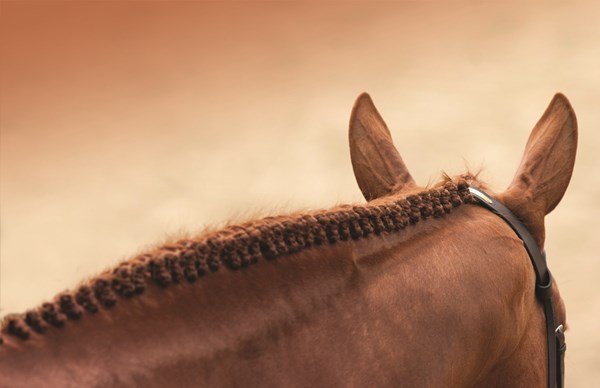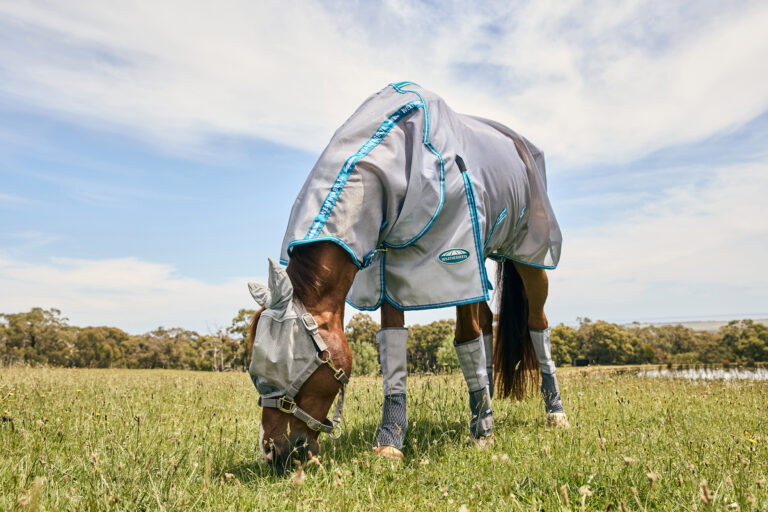Your horse is in his paddock, peacefully munching hay. Suddenly he stops chewing, lifts his head, pricks his ears and stares intently at the horizon. He’s heard a distant sound, so faint that your ears couldn’t detect it.
 © Amy K. Dragoo
© Amy K. DragooBeing fine-tuned to his surroundings is part of your horse’s nature, and a keen sense of hearing is a big part of that. In this article, two experts shed light on how hearing helps horses make sense of his environment and how to handle hearing-related problems. Allison J. Stewart, BVSC, DACVIM, DACVECC, is a professor of equine internal medicine at Auburn University. Bonnie Beaver, DVM, focuses on animal behavior as a professor at Texas A&M University.
A horse’s hearing isn’t very different from yours, the experts say. You can detect sounds with wave frequencies from 20 hertz (lowest pitch) to 20,000 hertz (highest pitch); for horses, the range is 55 hertz to 33,500 hertz. “They can’t hear quite as low as we can and can hear just slightly higher,” Dr. Beaver says. Many animals, including dogs, hear higher-pitched sounds; many can hear lower.
But horses excel at capturing faint sounds that you may easily miss and honing in on the directions sounds come from. Their ears contain the same structures yours do, but differences in design enhance these abilities.
What Big Ears You Have
Those big ears make a big difference. With its large size and cupped shape, each outer ear (pinna) is like a radar dish, collecting and concentrating sound waves. You have to turn your head to focus on the source of a sound, but your horse has ten muscles that can rotate each pinna in a full 180-degree arc—and he can move them independently, so that one turns forward while the other aims back.
The pinna funnels sound waves into the ear canal, which amplifies them in the same way that talking into a tube amplifies sound. At the middle ear the sound waves strike the eardrum (tympanic membrane), making it vibrate. The vibrations travel through the membrane to the ossicles, three tiny bones on the far side. These bones—called the hammer, anvil and stirrup for their shapes—form a chain that transmits the vibrations to a second membrane, which marks the start of the inner ear.
The inner ear holds sensory organs for both hearing and balance. The cochlea is the hearing part. It’s shaped like a snail shell and filled with fluids that move as vibrations from the membrane travel through them. The movement stimulates tiny hair cells (cilia) that send nerve signals to the brain. Different hair cells are sensitive to different sound frequencies.
Inner-ear fluid also circulates through the semicircular canals, which help the horse stay steady on his feet and in balance. The canals are lined with sensory hair cells and set at different angles, so they detect different movements—side-to-side, up-and-down, angled.
Run First, Ask Later
A twig snaps and your horse is off like a shot. His hair-trigger reactions are nerve-wracking when you’re riding or handling him, but they developed as a defense against predators. Back when his ancestors were wild, horses that didn’t run when a twig snapped were likely to be dinner for lions. Those that took off survived, and over generations that quick flight response became hardwired.
All horses share the basic response, but reactions to sudden sounds vary from one horse to the next. When a pebble hits the arena wall, one horse may spook 10 feet sideways while another barely alters his stride. Genetics and experience account for the differences, Dr. Beaver says. “Some individuals are ‘spookier,’ and that can have a genetic basis. Other individuals have not had experiences that would expose them to different environments that contain noise, so they may overreact,” she says. “We haven’t done enough hearing tests to know if there are differences in sensitivity to sound. If there are, they are probably minor.”
“The best way to deal with these episodes is to stay calm and guide the horse away from the perceived danger,” she adds. “A calm, consistent rider is best for horses that tend to react, so that they learn to trust the rider.” Punishing a horse for spooking will only reinforce his fear.
Exposing the horse to sounds in non-frightening situations is the best way to teach him to accept them, Dr. Beaver adds. The techniques of desensitization and counter-conditioning can help. In desensitization, the horse is exposed to the sound when he’s in a safe and familiar environment. (Think of Anna Sewell’s Black Beauty, who was pastured next to railroad tracks so he would learn to accept the terrifying sight and sound of trains.) In counter-conditioning you reward the horse while he’s exposed to the scary sound, typically with treats like carrot bits or feed pellets, so he comes to associate the sound with something pleasant. In both techniques it’s important to start with short sessions and low noise levels, increasing only as he tolerates the sound.
“Horses tend to respond to sounds separately,” Dr. Beaver says, so don’t assume that your horse will apply what he learns to new situations. He may realize that the sound of a tractor grooming the arena is not a threat, but that doesn’t mean he’ll accept the sound of a tractor-trailer coming up behind him on the road.
Cotton or equine earplugs can muffle sounds when sudden noises may be a problem—when construction is going on nearby, say, or in a snow-covered indoor arena where ice may abruptly slide off the roof. (Check the governing rules for your discipline before using earplugs in competition, though. They’re not allowed in dressage.)
Even with earplugs, some horses are so freaked out by loud sounds such as thunder and fireworks that they can injure themselves (or you) in their panic. When storms move in (or July 4 rolls around) these horses are safest in their stalls.
Hearing Loss
It’s likely that many horses lose some hearing ability with age, Dr. Stewart says, although this is something that hasn’t been widely tested. Researchers in Australia recently compared hearing ability in two groups of horses, ages 5 to 8 and ages 17 to 22, and found mild to moderate losses in the older group. (The researchers used brainstem auditory evoked response, or BAER, testing, in which electrodes attached to the skin of the horse’s head monitor the brain’s response to clicking sounds.) People also hear less well as they age—a lifetime of exposure to noise takes a toll on the sensory receptors in the inner ear. Dr. Beaver says that horses may suffer less loss than people do. “Horses don’t live as long or in the same environments [think rock concerts and iPods] as humans,” she notes. Day to day, you probably won’t notice mild hearing loss in your horse.
Deafness is rare in horses. It can be ruled out by electronic testing or simply by checking the horse’s reaction to a sudden noise, like clapping your hands or dropping a bucket. The sound should prompt a startle reaction—at minimum, a twitch of an ear. If the horse shows no response at all, he probably can’t hear it.
A congenital form of deafness occurs in some horses with “splashed white” coat patterns, Dr. Stewart says. A splashed white horse has an extremely wide blaze or “bald” face, often with blue eyes, and variable white markings on the legs and body. Some of these horses are born deaf. Researchers have identified three separate genetic mutations that can produce the pattern. Two turned up only in Paints and Quarter Horses, and the third appeared in those breeds as well as in Morgans, Trakehners and a few other breeds.
Splashed white horses have white faces and blue eyes because, during development, their genes suppress pigment-producing cells called melanocytes. If the lack of pigment extends into the inner ear, it affects the sound-sensitive hair cells and leads to deafness, Dr. Stewart says. Not all white markings come with the same risk of deafness, and horses can be tested for the splashed white mutations. (The University of California, Davis, offers a test.)
Hearing should be tested as part of a pre-purchase exam, Dr. Stewart says. But, she notes, deafness isn’t a huge handicap for a horse. Because a deaf horse doesn’t hear what’s going on around him, he obviously won’t spook at sounds—but he may spook if something suddenly touches him or pops into view without warning. “It’s usually not a problem if you don’t sneak up behind the horse,” she says.
Dr. Beaver agrees. “Hearing is often a first or second alert system for potential predators, and that isn’t much of a factor for most horses today,” she says. You may need to modify your aids, she adds—“obviously things like ‘whoa’ won’t work”—but most deaf horses adapt well. Many have had successful show careers.
Pinna Problems
The most common ear conditions in horses are ones you can see—skin problems that affect the pinna.
Fly bites. Black flies and other biting flies love horses’ ears, and the bite sites can become inflamed, crusty, itchy and sometimes infected. Use a topical antibiotic ointment to help control infection while the bites heal. Keep the flies away by using repellents, a fly mask with ear covers for turnout and an ear bonnet when you ride. Avoid clipping the ears unless you must do so to treat an infection—the hair helps protect the skin from bites.
Aural plaques. Aural plaques are flat, scaly, whitish growths on the inside (concave) surface of the pinna. They’re caused by papilloma viruses that are often spread by biting black flies. “Ignore them,” Dr. Stewart says. Although the plaques don’t look pretty, they do no harm to the horse. Attempts to remove them typically cause so much discomfort that the horse becomes sensitive about having his ears handled. Use the steps above to prevent black flies from getting to the ears. These flies are most active around dawn and dusk, so keep the horse in at those times.
Sarcoids. The ears are a prime spot for these common skin tumors, Dr. Stewart says. Sarcoids are not malignant but can grow aggressively. They can appear as hairless, scaly areas; hard bumps under the skin; or warty or fleshy growths. Some become raw and irritated, and some grow massive and cauliflower-like. It’s thought that infection with bovine papilloma virus, the cause of warts in cattle, may trigger the growths.
“Sarcoids are unsightly, but we generally leave them alone unless they are so large that they cause a problem for the horse,” Dr. Stewart says. There are many different treatments—surgery, cryotherapy (freezing), chemotherapy, radiation and more—but none is a sure bet, and the tumors tend to grow back. “Treatment overall has a 70 percent success rate. You may need to retreat several times,” she says. “The horse may come to vigorously resent having his ears handled, and the ear can be disfigured.”
So far no one has found a way to prevent sarcoids. Good fly control may help, however, as flies can spread the virus. Treatment with the chemotherapeutic drug cisplatin seems to slow the regrowth of these tumors. The drug is injected or released by implanted beads.
Deep Trouble
If a horse has a problem deeper in the ear, he may shake his head or hold the affected ear at an odd angle, tipped down to the side, because it’s irritated. He may also object to having the ear handled, but this isn’t a reliable sign. “Ears are sensitive and are naturally something to be protected. If the horse has also had a painful experience or been mishandled, especially while being clipped, it can aggravate the avoidance behavior,” Dr. Beaver says.
Ask your veterinarian to examine the ear. Dr. Stewart says it’s difficult to see into the ear canal even with an otoscope, the device used in many other animals as well as people, because the horse’s canal has a 90-degree bend. The vet can get a better look using a small flexible endoscope. The exam might discover:
Ticks. Ticks can attack the ear canal as well as the pinna. A type of tick found in the Southwest, the spinous ear tick, is especially known for this; infestation with these ticks can cause pain, inflammation and sometimes even muscle spasms. The horse will need to be heavily sedated for the ticks to be located and removed.
Mites: These tiny tick relatives can also get into the ear canal, although they are less common in horses than in some other animals. Deworming with ivermectin can help control them.
Infection:Ear-canal infections of the sort that plague dogs and cats are very rare in horses. “I haven’t seen one in 20 years. In a small animal practice, you’d expect to see one every day,” Dr. Stewart says. Bacterial infections can result from tick infestation, though. They are treated with topical and systemic medications.
Middle-ear infections are also extremely rare in horses, but they occur. Infection can spread from the respiratory system by way of the Eustachian tubes, which link the middle ear to the pharynx, or the guttural pouches, which open off the Eustachian tubes. It can also reach the middle ear from the outer ear canal or through the blood. These infections are treated with systemic antibiotics.
Ear Talk
Horses use body language to communicate with each other. Head and body positions, facial expressions and tail action all speak volumes. But for a quick read on what a horse is thinking, just look at his ears.
Ears held loosely to the side: “Just chillin’.” He’s relaxed.
Ears pricked forward: “What’s up?” If what he hears is really interesting (or alarming), he turns to face the sound and freezes in place.
Ears back: “I don’t like this.” He may be worried, fearful or feeling discomfort.
Ears pinned flat back: “Get out of my space!” He means business.
Ears shifting forward and back: “Lots going on here.” Constant motion is the default mode for a horse’s ears, helping him keep tabs on his surroundings. Rapid flicking can suggest nervousness; you’ll often see this when a horse is in a new environment with unfamiliar noises.
One ear back: “I’m listening.” He may be focusing on his rider or a horse approaching from behind with one ear, but he’s still scanning his surroundings with the other.
Ears drooping: “Tuned out.” Ears may droop when a horse is dozing, doped or sick. This can also be a sign of submission.
This article originally appeared in the November 2014 issue of Practical Horseman.











